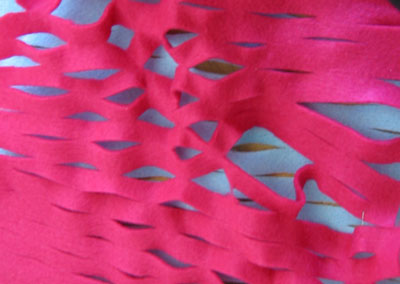
| > | Home | > | Participants | > | Mailing Lists |
| > | How To Enter | > | Sponsors | > | Theme Song |
| > | About ArtBots | > | Press Archive/Info | > | Previous Shows |
| > | FAQs |
 |
|

Open SesameSean Salmon, James Tichenor, Vasil Daskalopoulos, Phillip Stanley-Marbellsythetic felt, nitinol, custom pcb boards (2004) In 1851 Gottfreid Semper Published The Four Elements of Architecture in which he divided the practice of architecture in to the study of four basic elements: (1) the earthwork, (2) the hearth, (3) the framework/roof, and (4) the lightweight enclosing membrane. Of these four elements Semper placed the greatest emphasis of research d importance on the lightweight membrane that was traditionally a textile. This woven surface was seen as having a perceptual primacy as the horizontal surface in architecture, and to better understand our perception and the possibilities of this surface required the technical study of how this surface is constructed. The technical innovations of the early twentieth century in building construction allowed architects to leverage Semper's ideas of a textile surface as enclosing membrane into modernisms ideas of "free-plan" and "free-facade". Accepting the lightweight woven membrane as the primary architectural element, this project looks to incorporate the transformative power of electricity and information into the craft of production of a wall surface. Our robot will be a surface that opens and blooms in response to the sounds of the visitors. Hung on the existing walls as a wall surfacing element this second surface consists of layers of felt that are cut in patterns that allow the surface to open, revealing an psychedelic array of shifting patterns and colors. Pulling from the world of the baroque and drug soaked psychedelica the surface similarly presents an altered state of reality in with the surface of the walls dissolve and responds to our actions as viewers. The electronics of the piece are fairly simple; it uses a series of small microphones as sensors distributed across the surface to measure volume levels at points. This information is fed to a microcontroller that in-turn actuates a network of shape memory alloy wires. The intelligence or craft of the project is in the leveraging of a technical understating of how a woven surface can be made to increase the expressive and perceptual effects of the electronics in the project. That is, there is an interplay between the laser-cut incisions on the felt plane and the network of vector lines of the actuator wires that creates a shallow space surface of complexity.
After completing degrees in architecture at the New Jersey Institute of Technology, Sean Salmon and James Tichenor have worked together under the name FourPlus, exploring ideas of space and interactivity in as series of installations at locations ranging from the annual D.U.M.B.O arts festival to noise music performance spaces. James has completed Masters Degree in Design in Computation at MIT's Department of Architecture where he worked as a researcher designing and prototyping reactive surfaces and researching their position in art/architectural history of decorative arts. This fall he will be a researcher at Interaction Institute Ivrea. Sean Salmon, after getting his architectural license, is returning to academia to study at ITP at NYU in Fall 2004. Vasil Daskalopoulos and Phillip Stanley-Marbell collaborate on software projects for the Inferno operating system. Vasil is continuing his computer engineering education at Rutgers and Phillip is a researcher is at Carnegie Mellon focusing on smart matter
|
| All materials on this website copyright 2000-2022 douglas irving repetto and the individual artists. |